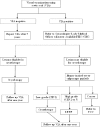Cervical Cancer Screening in Resource-Constrained Countries: Current Status and Future Directions
- PMID: 28669152
- PMCID: PMC6373785
- DOI: 10.22034/APJCP.2017.18.6.1461
Cervical Cancer Screening in Resource-Constrained Countries: Current Status and Future Directions
Abstract
Cervical cancer continues to be a major public health problem affecting large numbers of women in many developing countries. Limitations of various screening modalities and the lack of ready availability of a cost-effective point-of-care screening tool have hindered the efficient implementation of population-based screening programs in these settings. It has not proved possible for many countries to adopt cytology as a screening modality due to inadequate infrastructure and trained manpower. However, recent developments, notably design and testing of a low-cost HPV test kit and initiatives by countries like India in developing and putting into operation a framework for large-scale screening of women, have raised hopes that cervical cancer control may be possible even in resource-constrained locations. With the advent of HPV vaccination, primary prevention of cervical cancer also seems a distinct possibility. However, wide availability and acceptability of vaccination is still an unresolved issue for developing countries. The possible future effects of vaccination on test characteristics of various screening strategies also need to be evaluated. This review gathers information on the current status of cervical cancer screening with a special focus on low resource settings. It revisits the strengths and limitations of the available screening modalities for cervical cancer viz. cytology, visual methods and HPV testing, in the context of their applicability in developing countries. In addition, the role of newer HPV-detection methods, for instance DNA, RNA and protein-based techniques, in triage of screen-positive women is discussed. The contemporary issue of impact of HPV vaccination on cervical cancer screening is also addressed briefly. The main highlight of the review is the reference to ‘operational framework guidelines’ for population-based cervical cancer screening, which have recently been formulated and are in the process of being implemented in India. The guidelines may serve as a model for other similar low-resource settings where implementation of cancer screening is desired.
Keywords: Cervical cancer; screening; low resource settings; HPV; vaccination.
Creative Commons Attribution License
Figures
References
-
- Alameda F, Espinet B, Corzo C, et al. 3q26 (hTERC) gain studied by fluorescence in situ hybridization as a persistence-progression indicator in low-grade squamous intraepithelial lesion cases. Hum Pathol. 2009;40:1474–8. - PubMed
-
- Arbyn M, Raifu AO, Weiderpass E, Bray F, Anttila A. Trends of cervical cancer mortality in the member states of the European Union. Eur J Cancer. 2009;45:2640–8. - PubMed
-
- Blumenthal PD, Lauterbach M, Sellors JW, Sankaranarayanan R. Training for cervical cancer prevention programs in low-resource settings: focus on visual inspection with acetic acid and cryotherapy. Int J Gynaecol Obstet. 2005;89:30–7. - PubMed
-
- Brotherton JM, Fridman M, May CL, et al. Early effect of the HPV vaccination programme on cervical abnormalities in Victoria, Australia: an ecological study. Lancet. 2011;377:2085–92. - PubMed
Publication types
LinkOut - more resources
Full Text Sources
Medical


